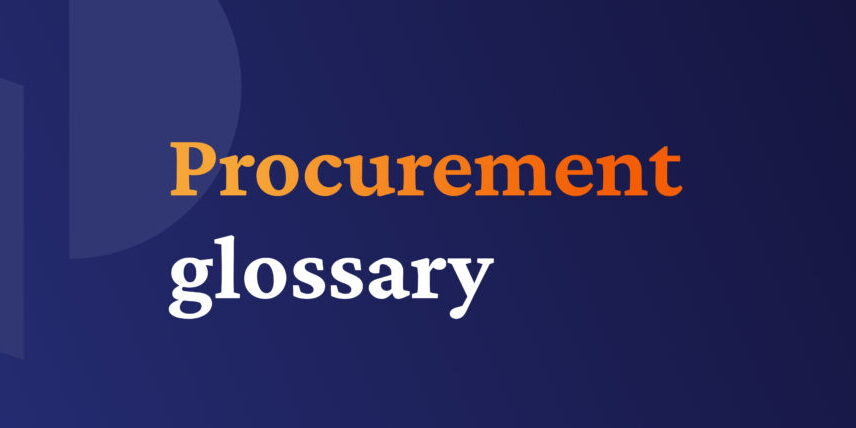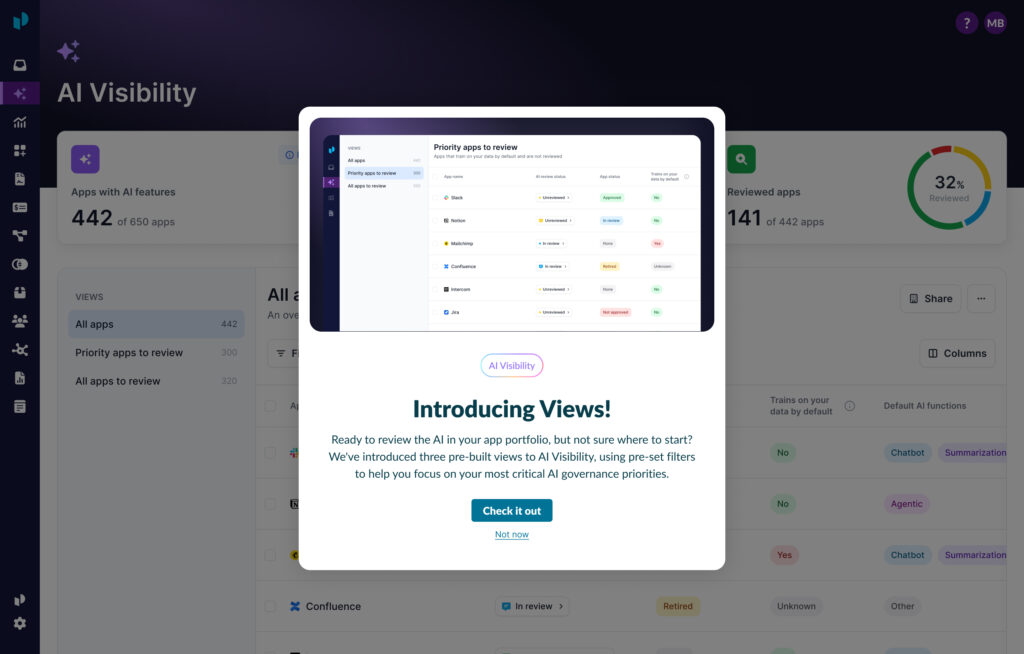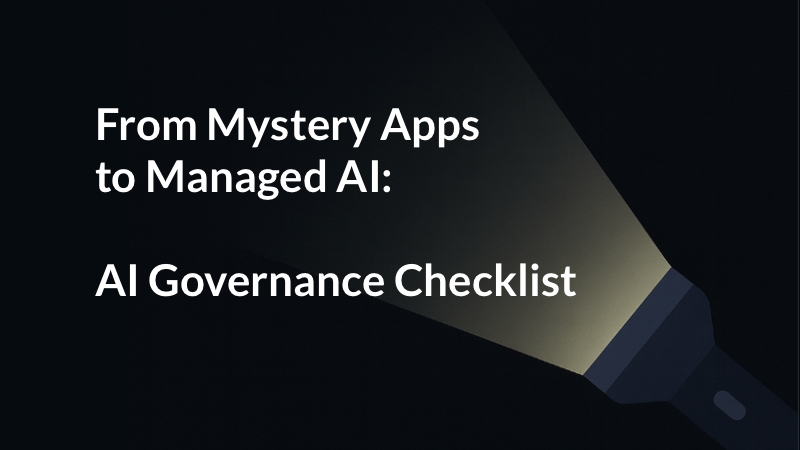
SaaS Procurement glossary: Key terms for every Procurement professional
Whether you’re a seasoned Procurement professional or just starting out, navigating the world of SaaS acquisition can be tricky. As we continue to embrace cloud-based software, the art of acquiring SaaS solutions has emerged with a stronger focus. Managing the acquisition of goods and services is crucial for any business, however, unlike traditional software purchases, SaaS requires a different approach to ensure you get the right tools at the best value. This glossary serves as your one-stop shop for deciphering the essential terminology used in Procurement.
A
Application Programming Interface (API)
An Application Programming Interface or API is a set of functionalities that allows a business to programmatically interact with the SaaS provider’s system, enabling automation and data exchange between procurement software and other business applications.
Accounts Payable
Accounts Payable refers to the department or process responsible for managing and paying bills for goods and services like subscriptions.
Acquisition
Acquisition is the process of identifying, evaluating, and selecting — either by purchasing or leasing — a solution to meet a specific business need. It can sometimes also refer to the cost incurred by the organization in acquiring a new customer.
Add-on
An add-on is an optional feature that extends the functionality of a base application to address specific user needs.
Amendment
An amendment is a change that modifies an existing contract or purchase order, typically changing aspects like pricing, service levels, or subscription duration.
Approval workflow
An approval workflow is a set of steps that a purchase request for software must follow to gain authorization, typically involving different stakeholders and multiple levels of hierarchy.
Approval hierarchy
Approval hierarchy is the level of spend a title is allowed to approve within an organization. Typically, the higher the spend, the higher the title must be to approve. Approval hierarchy protects an organization from unknown and unapproved spend from being pushed through.
Approved vendor
An approved vendor is a supplier that has been vetted and meets the organization’s criteria for security, functionality, and service, allowing for streamlined purchasing.
Assumption of risk
Assumption of risk refers to the potential negative consequences a business accepts by using a SaaS solution, such as security breaches or data loss.
Auto-renewal
A contract clause that legally allows a vendor to automatically renew a contract on a specific date without notice to the customer.
B
Blanket Purchase Agreement (BPA)
A Blanket Purchase Agreement, or BPA, is a pre-negotiated contract that streamlines purchases from a specific vendor for various SaaS solutions over a defined period.
Bottleneck
A bottleneck is any step or process that significantly slows down the acquisition of a solution, hindering efficiency and potentially delaying project timelines.
Business Process Outsourcing (BPO)
Business Process Outsourcing, or BPO, refers to contracting a third-party specialist to handle non-core business functions, like vendor selection or customer service.
Budget variance
Budget variance is the difference between the planned cost of a solution and the actual amount spent, arising from unforeseen needs or changes in usage.
Business Process Management (BPM)
Business Process Management, or BPM, is the systematic analysis, design, optimization, and automation of the processes involved in acquiring and managing SaaS solutions.
Business spend
Business spend is the total cost incurred by an organization for acquiring and using software, including subscription fees, add-on costs, and potential implementation or overage charges.
Buyer Enablement
Buyer enablement equips internal teams with the knowledge, resources, and tools to confidently make informed purchasing decisions.
Backup
A backup refers to creating copies of data stored within an application to ensure it can be recovered in the case of a service disruption or accidental deletion.
Bandwidth
Bandwidth is the amount of data transfer capacity available for a SaaS solution, impacting factors like user activity, file storage needs, and overall application performance.
Breach of contract
A breach of contract occurs when either the vendor fails to deliver promised features or security, or the customer violates the usage terms outlined in the agreement, potentially leading to termination of service or legal action.
C
Category management
Category management is when a company’s spend is broken out into similar groups to be managed by a specific person or persons. For example, many enterprise companies split up their spend into specific categories like IT, revenue, etc.
Centralized purchasing
Centralized purchasing consolidates the acquisition process under a single team, ensuring consistent buying practices, better negotiation with vendors, and the reduction of overall costs.
Change Order (CO)
A change order, or CO, is a formal agreement that modifies the original terms of a contract, typically to address changes in scope, pricing, or service level.
Cloud computing
Cloud computing is the on-demand delivery of software applications over the internet, eliminating the need for on-premise infrastructure and simplifying the acquisition and management of SaaS solutions.
Cloud security
Cloud security involves assessing and mitigating risks associated with data storage and application access within the vendor’s cloud infrastructure.
Cloud services
Cloud services refer to the delivery of software applications over the internet, eliminating the need for physical hardware and simplifying the process of acquiring and managing those applications.
Compliance
Compliance is the adherence to a set of rules and regulations governing the procurement process. These rules and regulations can vary depending on the organization’s industry, location, and size. It protects an organization from legal liability, financial loss, reputation damage, and ensures that it gets the most value for its money.
Contract
A contract is a legally binding agreement between a customer and a vendor that outlines the terms of service for a SaaS solution, including pricing, features, service levels, usage rights, and termination clauses.
Contract management
Contract management is the ongoing process of creating, storing, monitoring, and enforcing the terms of SaaS contracts to ensure compliance, optimize costs, and mitigate risks for the organization.
Cost avoidance
Cost avoidance refers to proactive strategies that prevent unnecessary expenses, such as choosing a solution that eliminates the need for costlier alternatives or in-house development.
Cost efficiency
Cost efficiency means getting the most value out of a solution for the least amount of money, achieved through strategic selection, negotiation, and ongoing cost optimization practices.
Cost savings
Cost savings are the strategies and practices that reduce the overall expenditure on solutions, including optimizing subscriptions, negotiating better deals, and eliminating unnecessary licenses.
Counteroffer
A counteroffer is a revised proposal from the customer responding to the vendor’s initial pricing or terms, aiming to secure a more favorable agreement for their needs.
Customer Relationship Management (CRM)
CRM, or Customer Relationship Management, is a software that can manage vendor interactions, track proposals and contracts, and streamline the entire application acquisition process.
D
Dashboard
A dashboard provides a visual summary of key metrics and insights, enabling users to monitor spend, track contract renewals, and identify areas for cost optimization or process improvement.
Data migration
Data migration is the process of transferring existing data from one system to a new solution, ensuring historical information and user continuity.
Direct procurement
Direct procurement refers to the process of attaining materials, goods, and services that an organization needs to create their product or offering — either in part, or in whole.
Due diligence
Due diligence is the careful examination of a vendor’s security, financials, and capabilities to ensure the solution aligns with your needs and minimizes potential risks before signing a contract.
E
Employee offboarding
Employee offboarding is the process of revoking a departing employee’s access to SaaS applications to prevent security risks and unnecessary subscription costs.
Employee onboarding
Employee onboarding involves provisioning new hires with access to the necessary SaaS applications and potentially including training to ensure they can effectively utilize them for their job duties.
Encryption
Encryption refers to the scrambling data both at rest (stored on the vendor’s servers) and in transit (traveling between you and the application) to safeguard sensitive information from unauthorized access in case of a security breach.
Enterprise
An enterprise is a large organization with complex needs that often requires robust features, scalability, and enterprise-grade security.
Enterprise license
An enterprise license caters to the needs of large organizations and typically includes features like bulk user seats, advanced security controls, and priority customer support.
Enterprise License Agreement (ELA)
An enterprise license agreement, or ELA, is a formal contract between a vendor and a large organization outlining the terms and conditions for using software across the organization.
E-Procurement
E-procurement refers to utilizing electronic systems to manage the entire SaaS acquisition process, streamlining tasks like requisitioning, vendor selection, and contract management.
Enterprise Resource Planning (ERP)
ERP, or Enterprise Resource Planning, systems can integrate with applications to facilitate data exchange between a SaaS solution and other enterprise systems used for finance, inventory, or customer relationship management.
F
File Transfer Protocol (FTP)
File Transfer Protocol, or FTP, is a method used to transfer large data files during the data migration stage.
Financial savings management
Financial savings management refers to strategies that optimize spending on cloud-based software, focusing on cost reduction through methods like right-sizing subscriptions, negotiating better deals, and identifying opportunities to eliminate unnecessary SaaS products.
Firewall
A firewall is a security measure that is implemented by the organization to control incoming and outgoing network traffic, potentially restricting access to certain SaaS applications to mitigate security risks.
Framework agreement
A framework agreement in SaaS procurement, while not as common as a Master Services Agreement (MSA), can be used to establish a pre-approved list of vendors or a standard set of terms for acquiring various solutions, streamlining future purchases.
FP&A Alignment
The FP&A, or financial planning and analysis, team requires other team members to get alignment from them before approving budget, headcount, and other needs.
Full-text search
Full-text search allows you to scan entire contracts, proposals, or other documents for specific keywords or phrases, facilitating faster retrieval of relevant information during the acquisition process.
Fulfillment
Fulfillment is the vendor’s act of provisioning access and setting up the SaaS solution for the customer, ensuring it’s ready for use upon activation.
Future planning
A step beyond budgeting, future planning takes cash flow, company growth, and headcount growth specific to each team, all into account.
Future proofing
Every contract should be reviewed for acceptable legal and commercial terms. The act of future proofing ensures that these terms are structured to support the business in the future, not just at the time the contract is executed.
G
Generalist
A generalist is a procurement person that is highly skilled in all types of purchases as opposed to one category of purchases. Generalists tend to manage larger books of business and are well versed in legalese across the business.
Globalization
Globalization considers factors like international data privacy regulations, multi-language support, and regional pricing structures when selecting and deploying SaaS solutions for a geographically diverse workforce.
Graphical User Interface (GUI)
A Graphical User Interface, or GUI, refers to the visual interface used within the platform, allowing users to navigate, manage, and track an entire acquisition process through icons, menus, and buttons.
Green Procurement
Green procurement focuses on selecting cloud-based solutions with eco-friendly practices, such as energy-efficient infrastructure or features that encourage paperless workflows, to minimize the environmental impact.
H
Hard savings
Hard savings are tangible reductions that directly impact the company’s bottom line. For example, savings from budgeted spend, volume reduction, refunds and rebates.
Helpdesk
A helpdesk is a resource for internal users encountering issues or needing assistance with an application or software.
Hosting
Hosting refers to the vendor’s responsibility for managing the underlying infrastructure and data centers that power a SaaS application, freeing the customer from hardware and maintenance concerns.
I
Indirect Procurement
Indirect procurement is the method of obtaining products and services that support a business’s operations. They are essential to the business but do not directly input to your finished product or services.
Infrastructure
Infrastructure is the underlying hardware, software, and data centers managed by the vendor that power applications.
Integration
Integration is the process of connecting a new application or software with existing enterprise systems to enable data exchange and ensure smooth workflows between them. This can involve APIs or other methods to share information seamlessly.
IT Asset Management (ITAM)
IT Asset Management generally refers to the team or the motion of managing all in-house IT needs and assets, including hardware and software. ITAM may also be involved in the procurement of IT needs.
IT reseller
An IT reseller acts as an intermediary, helping customers identify, purchase, and potentially implement SaaS solutions, often adding their own services or expertise.
Invoice
An invoice is a detailed bill issued by the vendor outlining the charges for the SaaS subscription, including any additional fees or prorated costs, for a specific billing period.
K
Key Performance Indicator
A Key Performance Indicator, or KPI, is a measurable value that reflects how well specific goals are being achieved throughout the process of acquiring and using SaaS solutions. These KPIs can track aspects like cost savings, user adoption, contract optimization, or speed of implementation.
L
Lead time
Lead time is the duration between initiating a request to procure a SaaS solution and its complete deployment and user readiness.
Legal review
A legal review is the process of the legal team — or a legal representative — reviewing contracts and/or terms. This review generally includes the redlining of a contract, negotiating those redlines in collaboration with Procurement, and determining risk tolerance that is acceptable for the organization.
Legalese
Legalese is a specialized form of language often used by lawyers and members of the legal community to discuss legal definitions, terms, laws, and contracts. At its core, legalese is designed to remove confusion and ambiguity from a legally binding contract.
Letter of Intent (LOI)
A Letter of Intent, or LOI, is a non-binding preliminary agreement that outlines the basic terms of a future contract, but doesn’t legally obligate either party to proceed. It can express interest, establish a negotiation framework, and potentially outline exclusivity or confidentiality terms.
Licensing
Licensing is the legal agreement that defines the terms under which a customer is authorized to access and use an application or software, specifying usage rights, limitations, and intellectual property ownership.
M
Maturity model
A maturity model is a framework that helps organizations assess their current capabilities in acquiring and managing solutions, and identify areas for improvement to achieve strategic goals and optimize value. It typically covers aspects like process standardization, automation, governance, and talent development.
Maverick buying
Maverick buying is the unauthorized or uncontrolled purchases of SaaS subscriptions by employees outside of the designated procurement process, potentially leading to shadow IT, wasted spending, and security risks.
Mobile compatibility
Mobile compatibility is a SaaS solution’s ability to be accessed and function effectively on various mobile devices (smartphones, tablets) ensuring a seamless user experience across platforms.
Multitenancy
Multitenancy is a single instance of an application serving multiple customers (tenants). Each tenant’s data is isolated and secure, but they all leverage the same core infrastructure, offering benefits like scalability and cost-efficiency for both the vendor and the customer.
Master Service Agreement (MSA)
A Master Service Agreement, or MSA, in SaaS procurement is a standardized contract template established by a vendor that outlines the general terms and conditions for all its SaaS offerings. This streamlines the negotiation process for both parties and ensures consistency across different products from the same vendor.
N
Negotiation
Negotiation is the process of discussing and agreeing upon the terms of a contract, covering aspects like pricing, service level guarantees, contract duration, and termination clauses, to achieve a mutually beneficial agreement for both the customer and the vendor.
O
Operational procurement
Operational procurement are the ongoing tasks and processes involved in managing subscriptions after the initial acquisition. This includes activities like user management, license optimization, spend monitoring, contract renewals, and ensuring adherence to the agreed-upon terms with the vendor.
Outsourced vendor management
Outsourced vendor management refers to delegating the tasks of managing vendor relationships, overseeing contract performance, and optimizing subscriptions to a specialized external company, allowing your internal team to focus on core business functions.
Outsourcing
Outsourcing refers to delegating specific tasks or the entire process of acquiring and managing solutions to a third-party specialist.
P
Payment terms
Payment terms define the schedule and methods for paying for your subscriptions, including frequency (monthly, annually), acceptable payment methods, and potential discounts for upfront or longer billing cycles.
Platform
Platform refers to the underlying infrastructure, often managed by the vendor, that delivers and runs an application.
Privacy policy
A privacy policy is a legal document outlining how the vendor collects, uses, protects, and discloses your data when you use their SaaS application.
P2P (Procure-to-Pay or Purchase-to-Pay)
P2P, Procure-to-Pay or Purchase-to-Pay, in general refers to the integrated process used by organizations to manage the entire procurement lifecycle, from requisitioning goods and services to making payments. This encompasses tasks like purchase order generation, vendor communication, invoice approval, and payment processing.
Procurement
Procurement refers to the process of acquiring goods, services, or works from an external source to meet an organization’s needs. It involves activities like identifying requirements, sourcing vendors, negotiating contracts, placing orders, receiving deliveries, and making payments.
Procurement cycle
The procurement cycle refers to the series of steps involved in acquiring goods, services, or works from an external source to meet an organization’s needs.
Procurement value
Procurement value is the overall benefit or strategic advantage an organization gains from the procurement process, considering factors like quality, total cost of ownership, risk mitigation, innovation, and alignment with business goals.
Proof of Concept (POC)
The Proof of Concept or POC is a demonstration of how the software will work in a real-world environment. It is typically conducted before the software is published to ensure that it meets the needs of the organization. A POC can be conducted in a variety of ways
Proposal
A proposal is a formal document submitted by a vendor outlining their solution, qualifications, and pricing in response to your request for a SaaS solution. It essentially convinces you why their offering is the best fit for your needs.
Provisioning
Provisioning is the process of setting up a SaaS application for use by your organization. This typically involves creating user accounts, assigning permissions, configuring settings, and integrating the solution with your existing systems to ensure a smooth user experience.
Purchase Order (PO)
A Purchase Order or PO is a document that was written by a buyer indicating intent to purchase but is not a bill. It generally outlines the details of a transaction and includes the goods or services to be purchased, delivery date, and price.
Purchasing power
Purchasing power is an organization’s ability to negotiate favorable terms and pricing for goods and services.
Q
Quotation
A quotation is a formal document from a vendor outlining their proposed pricing for a SaaS solution in response to a request for proposal (RFP) or inquiry.
R
Reliability
Reliability refers to the consistency and dependability of a SaaS application’s performance.
Request For Information (RFI)
An RFI, or Request for Information, is a document you send to potential vendors to gather details about their capabilities, experience, and solutions to help you shortlist and evaluate which ones best meet your requirements before issuing a formal RFP (Request for Proposal).
Request for Proposal (RFP)
An RFP, or Request for Proposal, is a formal document you issue to potential vendors outlining your specific requirements and evaluation criteria for a desired solution.
Request For Quotation (RFQ)
An RFQ, or Request for Quotation, is a formal document you send to shortlisted vendors after an RFI or RFP stage.
Return on Investment (ROI)
ROI, or Return on Investment, measures the financial benefit gained from a SaaS solution compared to its total cost. It considers factors like increased productivity, cost savings, and improved efficiency delivered by the SaaS application, divided by the cumulative investment in subscriptions, implementation, and ongoing management.
Risk analysis
Risk analysis involves proactively identifying potential security threats, vendor lock-in, service disruptions, and other challenges associated with acquiring and using software.
Risk management plan
A risk management plan is a formal document outlining strategies to identify, assess, prioritize, and mitigate potential risks associated with acquiring and using software. This plan helps organizations proactively address security vulnerabilities, vendor lock-in, compliance issues, and other challenges, ensuring a smooth and secure SaaS adoption process.
S
SaaS (software-as-a-service)
SaaS (software-as-a-service) is a cloud-based software delivery model where users access applications over the internet instead of installing and maintaining them on-premise. SaaS applications are typically subscription-based, with vendors providing ongoing maintenance, updates, and security.
SaaS Management
SaaS management refers to the practices, tools, and workflows used to oversee the entire lifecycle of SaaS applications within an organization, encompassing tasks like procurement, provisioning, user management, and cost optimization.
SaaS Management Platform (SMP)
A SaaS Management Platform, or SMP, is a software application that provides a centralized location to automate, manage, and govern the entire lifecycle of SaaS applications within an organization. This can include tasks like discovery, procurement, provisioning, user management, and spend optimization.
Scalability
Scalability refers to a solution’s ability to adapt to changing user demands and data volumes. An ideal SaaS solution should grow alongside your business, accommodating more users, features, and storage requirements without sacrificing performance or incurring significant extra costs.
Seat-based pricing
Seat-based pricing is a pricing model where the cost is directly tied to the number of users (seats) granted access to the application. Organizations typically pay a monthly or annual fee per user, with the total cost increasing as they add more users.
Security
Security involves evaluating the vendor’s measures to protect your data, including encryption, access controls, and disaster recovery plans, to minimize security risks and ensure business continuity.
Service Level Agreement (SLA)
A Service Level Agreement, or SLA, is a formal agreement between a customer and a vendor that defines the expected performance metrics for the SaaS application, such as uptime, response times, and data availability. The SLA often includes penalties for the vendor if they fail to meet these benchmarks.
Shadow IT
Shadow IT is the use of cloud-based applications without formal IT approval, often driven by employee needs and a lack of suitable centrally-managed options, which can create security vulnerabilities and complicate expense management.
S2P (Source-to-pay)
S2P, or Source-to-Pay, is the entire process of finding a solution that meets your needs, from identifying a business requirement to negotiating the contract, provisioning user access, and finally managing payments and ongoing use of an application.
Spend analysis
Spend analysis in SaaS procurement refers to the process of examining SaaS subscription data to identify spending trends, optimize costs, and ensure you’re getting the most value from your cloud-based software investments. This can involve analyzing usage patterns, identifying underutilized licenses, and negotiating better pricing with vendors.
Spend management
Spend management is the ongoing practice employed to control and optimize expenses associated with subscriptions throughout their lifecycle. This encompasses tasks like spend analysis, identifying cost-saving opportunities, negotiating better deals with vendors, and ensuring adherence to budget constraints.
Spend Management Platform
A spend management platform is a software tool that centralizes and automates various tasks involved in spend management, including spend analysis, subscription optimization, cost-saving opportunity identification, and vendor negotiation support. This streamlines the process and empowers businesses to make strategic decisions, maximize the value of their investments, and enables people to carry out their spend management strategy.
Strategic sourcing
Strategic sourcing involves a proactive approach to identify, evaluate, and acquire solutions that align with your business goals and deliver optimal value over the long term. It considers factors like functionality, scalability, security, vendor reputation, and total cost of ownership (TCO).
Subscription
A subscription is the recurring billing model for accessing a SaaS solution. Customers typically pay a monthly or annual fee to use the software application and receive ongoing updates, maintenance, and support from the vendor.
T
Terms and conditions
The terms and conditions (T&Cs) are the legal agreement outlining the rights and obligations of both the customer and the vendor regarding access, use, security, data privacy, and termination of a solution.
Third-party providers
Third-party providers are a diverse group of companies that offer various services and functionalities that complement the core SaaS offering. This can include data subprocessors, integration specialists, or value-added resellers that provide implementation, training, or ongoing support.
Trial Period
A trial period is a temporary, limited access to the full features of a solution, allowing potential customers to evaluate its suitability for their needs before committing to a paid subscription.
U
Uptime
Uptime is the percentage of time a SaaS application is available for users, a key factor evaluated during vendor selection to ensure minimal disruption and optimal business continuity.
User management
User management requires teams to establish who can access an application, assigning them appropriate permissions, and ensuring compliance with security protocols.
V
Vendor management
Vendor management is the ongoing process of building relationships, monitoring performance, and overseeing contracts with vendors to ensure they continue to deliver value and meet your organization’s needs.
Vendor sourcing
Vendor sourcing involves identifying and evaluating potential vendors that possess the features, functionality, and security requirements to meet your business needs.
Vendor portal
A vendor portal is a secure online platform that streamlines communication, facilitates document exchange, and enables self-service tasks between a business and its vendors.
Vendor relationship management
Vendor relationship management focuses on building strategic partnerships with vendors to ensure successful implementation, maximize value from a solution, and achieve mutually beneficial outcomes.
W
Web-based application
A web-based application refers to the type of software being procured. It’s a cloud-based solution accessed through a web interface, eliminating the need for local installations.
Workflow automation
Workflow automation refers to using technology to streamline repetitive tasks within the acquisition process, such as approvals, vendor communication, or data entry, improving efficiency and reducing errors.
Z
Zero-downtime deployment
Zero-downtime deployment is a deployment strategy used by vendors to minimize disruption when transitioning users to a new or updated version of an application.
About Productiv:
Productiv is the IT operating system to manage your entire SaaS and AI ecosystem. It centralizes visibility into your tech stack, so CIOs and IT leaders can confidently set strategy, optimize renewals, and empower employees.





